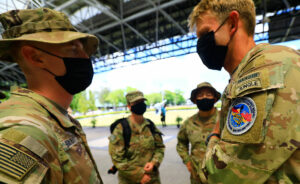Marcos rules out use of military bases to attack neighbor China

By Kyle Aristophere T. Atienza, Reporter
PRESIDENT Ferdinand R. Marcos, Jr. on Monday ruled out the use of Philippine military bases, access to which by American troops under a 2014 military pact has been widened, to launch offensives.
“We will not let our bases be used for whatever offensive actions,” he told reporters on the sidelines of a commemoration event for Filipino heroes of World War II.
The president said sites under the Philippines’ 2014 Enhanced Defense Cooperation Agreement (EDCA) with the US are aimed to help the Philippines.
In February, Mr. Marcos gave the US access to four more military bases under EDCA on top of the five existing sites.
China has criticized the EDCA expansion, accusing the US of endangering “regional peace and stability.”
“The result will inevitably be increased military tension,” Foreign Ministry spokeswoman Mao Ning told a news conference earlier this month.
But Mr. Marcos downplayed China’s fears, saying there’s no need to worry as long as no offensives take place.
“If no one attacks us, then they should not worry because we will not fight them,” he said, adding that the government is only “continuing to strengthen the defense of our territory and the republic.”
Senator Ronald M. dela Rosa, vice-chairman of the Senate defense committee, said China’s warning was a strategy to “discourage us from honoring our commitment” to the US.
“We should not be unfazed,” he told a news briefing on Monday, adding that the government should not let China bully the Philippines. Mr. Dela Rosa is among the lawmakers highly critical of the EDCA expansion.
Three of the four new EDCA locations will be in northern Philippines — Naval Base Camilo Osias in Sta Ana, Cagayan; Lal-lo Airport, also in Cagayan; and Camp Melchor Dela Cruz in Gamu, Isabela.
Cagayan is about 1,000 kilometers away from self-ruled Taiwan, which is being claimed by China. Balabac Island in Palawan, which is facing the South China Sea, is also on the list.
Philippine Defense spokesman Arsenio R. Andolong earlier said the Philippines aimed to finish the construction of the five existing EDCA sites by 2024. Washington has allotted more than $83 million (P4.5 billion) for the approved projects at these sites.
Mr. Andolong said building works at the five sites, which are in Cebu, Cagayan de Oro, Palawan, Nueva Ecija and Pampanga, had been delayed by the coronavirus pandemic and after former President Rodrigo R. Duterte’s termination of the country’s visiting forces agreement with the US.
The former president, who led a foreign policy pivot to China, restored the agreement a year later after a meeting with US Defense Secretary Lloyd James Austin III.]
Mr. Marcos’ assurance that EDCA sites would not be used for offensives assumes the US would not provoke Chinese aggression or fight back in case of an attack, said Hansley A. Juliano, a political economy researcher studying at Japan’s Nagoya University.
“It is also just a polite diplomatic code. Both China and the Philippines know you don’t stockpile arms or invite allies if you’re actually friends,” he said in a Facebook Messenger chat.
TRAINED GUNSLucio B. Pitlo III, a research fellow at the Asia-Pacific Pathways to Progress Foundation, said Mr. Marcos’s remarks on China’s warning “might convey that Manila is not giving Washington a carte blanche.”
It might also mean there would be discussion on how EDCA would be implemented, “including the number of US troops and types of weapons and equipment that will be posted there,” he said via Messenger chat.
EDCA, a supplementary deal to the 1999 visiting forces agreement, allows the US to rotate its troops in the Philippines and build and operate facilities on agreed locations for both their military forces.
Filipino troops and their American counterparts hold annual military drills in Philippine territories that are called “Balikatan” (shoulder-to-shoulder) exercises.
At the weekend, foreign policy experts said the Philippines should brace for more objections from China as Manila and Washington hold their largest-ever Balikatan exercises this month.
More than 17,600 members of the Armed of the Philippines and US military will participate in the war games on April 11 to 28. There will be observers from Japan, South Korea, the United Kingdom, France, India and Southeast Asian countries.
The drills will include live-fire exercises near disputed waters of the South China Sea, including a plan to sink a decommissioned fishing boat in San Antonio, Zambales on the main island of Luzon.
San Antonio is about 140 miles from Scarborough Shoal, a Philippine feature in the South China Sea that is claimed by Beijing. In 2016, an international court ruled that both traditional Chinese and Filipino fishermen have the right to fish there. China has ignored the ruling.
Mr. Marcos, 65, has vowed to pursue an independent foreign policy, which has been criticized especially after his government announced the EDCA expansion.
During the presidential campaign, he was accused of taking a friendly stance toward China, which has rejected the United Nations-backed arbitral ruling that voided its claims to more than 80% of the South China Sea.
“What can be decided by goodwill, diplomatic transmissions and even trade agreements are not always guaranteed when guns are trained at each other in the high seas,” Mr. Juliano said.




